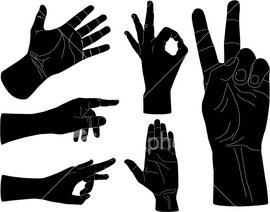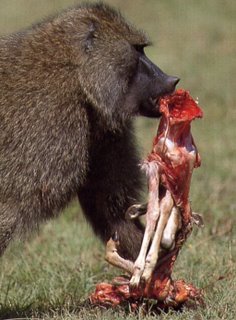 As reported by Maurice yesterday,
As reported by Maurice yesterday,"Today I had an interesting experience which told me something about how the mind works. I came across a gang of ten-year olds and asked them if they knew of a way to get across a nearby freeway. All the boys said they didn't know, which is a big improvement over just saying no. Then a girl told me what to do. I am never surprised by the superior intelligence of females. The interesting thing was that as she was giving me directions she was also gesticulating by moving her hand in a counterclockwise rising spiral. She never mentioned anything remotely like a spiral during her directions. When I got to the bridge she told me how to find, I saw that it was reached by walking up a rising counterclockwise spiral ramp. It is clear to me that she knew about this ramp, maybe even visualized it, and that's why she gesticulated the way she did."
All of this reminded me of two articles I've read about gesture.
Click here for one I've used as assigned reading in my nonverbal behavior seminar and here for media coverage of the other which is sure to make it into class discussion in my primate behavior class.
 Indeed, gesture does tell us something about how the mind works.
Indeed, gesture does tell us something about how the mind works.Not only does it pave the way for youngsters to learn language more quickly [see research abstract here], but it also helps us process information more efficiently. In psycho(research)babble this is called "lightening cognitive load." As soon as I discovered Susan Goldin-Meadow's research I was hooked. She totally changed my perspective on gesture. Previously I had only seen gesture as communicative in function, but they are far more than that. Perhaps the youngster Maurice observed gesturing a spiral was able to recall those directions better because she gestured. That's what Goldin-Meadow's research would suggest.
Very recently I read the following article, procured electronically through interlibrary loan the day after I requested it (isn't technology amazing?!):
Latéralité et communication gestuelle intentionnelle chez le babouin.
I didn't read it in French, I just like the title and spelling of "baboon" in French ;-) It looks comically elegant. I could read it in French if I wanted to, but thankfully for my optimal comprehension, it was published in English in Behavioural Brain Research:
Baboons communicate with their right hand.
 Evidently a couple of French psychologists observed captive baboons making hand slaps on the ground to intimidate other baboons (and humans). This is not a revelation. Baboonologists have known this for as long as they've been watching baboons. What is news is that finally a bunch of people sat down and logged serious observational hours tallying up the proportion of right vs. left handed hand slaps. Of course, you might be wondering why does it matter? Why would anyone record in meticulous detail the hand actions of a bunch of monkeys?
Evidently a couple of French psychologists observed captive baboons making hand slaps on the ground to intimidate other baboons (and humans). This is not a revelation. Baboonologists have known this for as long as they've been watching baboons. What is news is that finally a bunch of people sat down and logged serious observational hours tallying up the proportion of right vs. left handed hand slaps. Of course, you might be wondering why does it matter? Why would anyone record in meticulous detail the hand actions of a bunch of monkeys?Well, Meguerditchian and Vauclair's research is the first to show that a non-ape has a hand preference for communicative purposes, and as it turns out, most of them are not south paws. What's more, psychologists have known that speech/language capabilities are "lateralized" in the left side of the brain ever since a fellow Frenchy Paul Broca found that out about 150 years ago, and they've known for about 1o years that vocalizations in monkeys are similarly lateralized thanks to one of my favorite primate-psychologists, Marc Hauser, BUT ... they did not know until now that nonverbal communicative hand gestures are also likely left hemisphere lateralized in NON-APES.
You see, chimps tend to gesture with their right hand, which suggests that gestural
 communication and corresponding supportive brain structures were lateralized about 5-6 million years ago in our common ancestor. Now that we can see that baboons also make asymmetrical communicative gestures, we can guesstimate that primate brains became lateralized and prepared for language specialization much earlier than previously thought.
communication and corresponding supportive brain structures were lateralized about 5-6 million years ago in our common ancestor. Now that we can see that baboons also make asymmetrical communicative gestures, we can guesstimate that primate brains became lateralized and prepared for language specialization much earlier than previously thought.All of this comes down to trying to pinpoint the evolutionary origins of language, the most useful of human 'tools.'
What I really appreciated about this article in addition to all of the above, is that the authors (probably because of reviewer criticism or to head it off at the pass) proposed and then refuted a potential problem with drawing conclusions from a small sample size.
Think about this...
If you observed a baboon slapping the ground with its right hand 12 times, how could you be sure that she really is a right-handed baboon? What if in the other 273 times she slapped the ground Miss Baboon did so with her LEFT hand and you only happened to see that 12 times she did it with her right hand? What if during the week you observed her she primarily slapped the ground with her right hand but during the next week when you were crunching the numbers on your new data she slapped the ground 10/12 times with her LEFT hand?
To get around such sources of error, M & V looked at their data to see whether baboons who had fewer recorded hand slaps were more likely to be labeled as rightys. They weren't.
I always like to see this sort of problem discussed because it gives me a reason to get students to think critically about scientific research, statistics, and sampling.
The other thing I really appreciated about this article is that they observed baboons making the intimidating hand-slap gesture to other baboons as well as humans. It didn't make a difference who the intended receiver of this communicative signal was. Baboons did not didn't discriminate. That's not really surprising, but what made me laugh was that in order to get the baboons to slap the ground to a human receiver, all that person had to do was shake her head at the target baboon.
 I suppose if a baboon slapped the ground at me I might send a rude hand gesture back... from a safe distance. Have you seen their canines?!
I suppose if a baboon slapped the ground at me I might send a rude hand gesture back... from a safe distance. Have you seen their canines?!They eat meat.


4 comments:
This one made me smile...and i'd pass this infos to my Mom [in the Philippines] who is having troubles communicating with her monkey. Haven't seen the monkey yet cos she was adopted early this year when our neighbor decided to kill her if nobody wanted her. Anyway, Mom said her monkey is very naughty. Only grandma could tame her!We wonder why...by the way, it's my first time to know that not all monkeys are vegetarians. Thanks!
Very cool, and very informative. I hadn't thought of the hand gestures serving as a device for aiding thought, but I do use them myself for just such a purpose, usually at work.
I know I hang thoughts on invisible pegs when I am weaving to keep track of where I'm at, in addition to the usual mumbo jumbo of making up silly little songs to keep complex patterns straight.
I'm just glad nobody sees/hears the majority of these things. They've got to look strange from an outsider's perspective. Kind of like storing the power cord to my boom box in the battery compartment...
Thanks for your comment Nutbuk :-)
Baboons also eat garbage. For them, "couch baboons" (so-called because they're lazy about traveling to get food), a poor quality diet has the same gross effects it has on us humans: obesity, diabetes, heart disease, etc.
Check out the full story here:
http://record.wustl.edu/web/page/normal/1832.html
A good lesson for couch potatos around the world!
Post a Comment